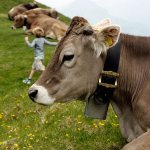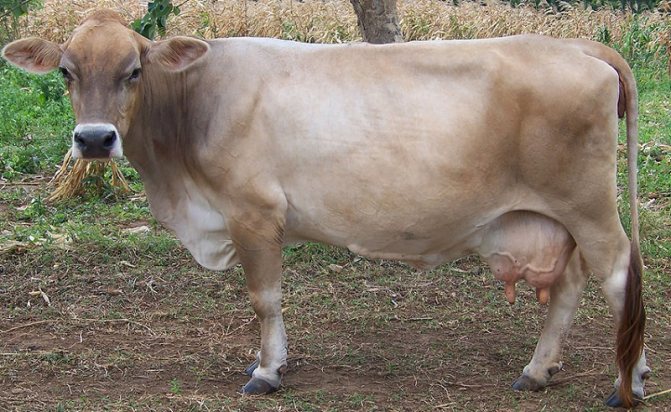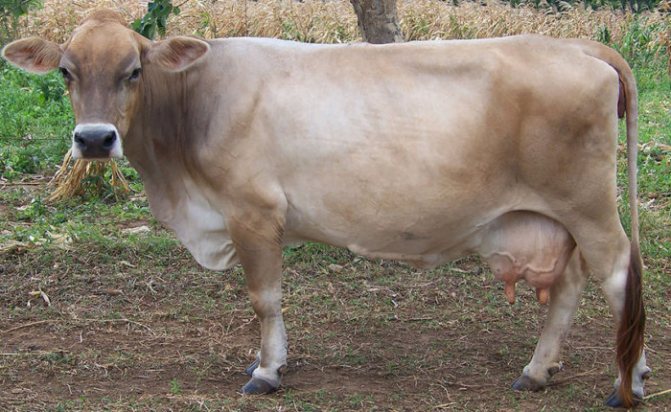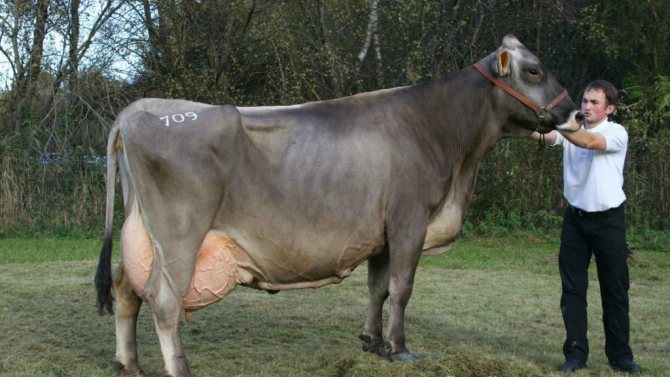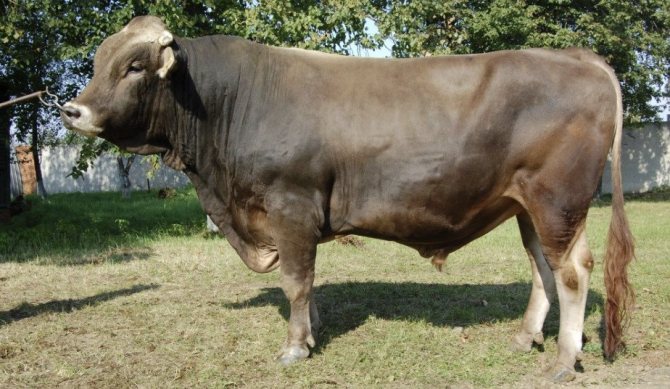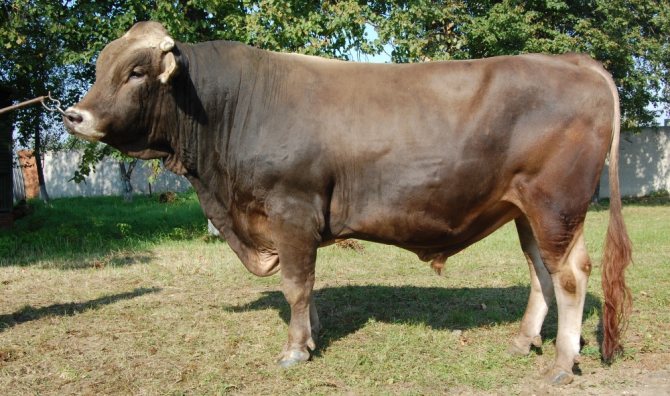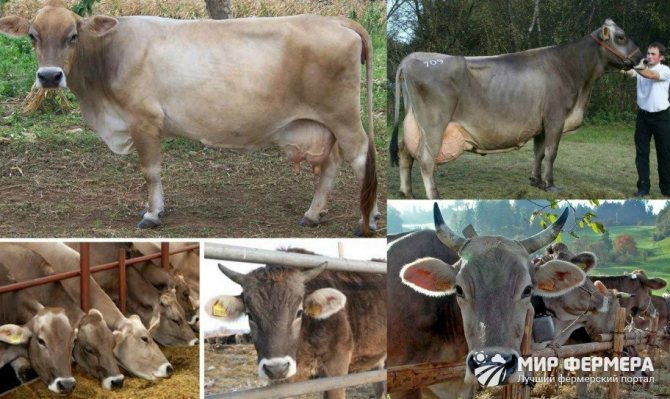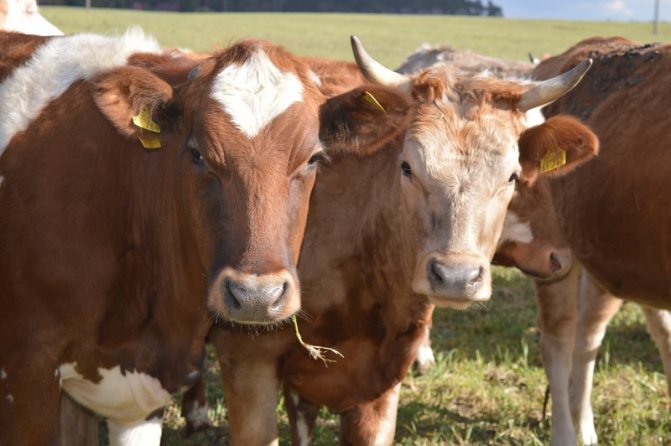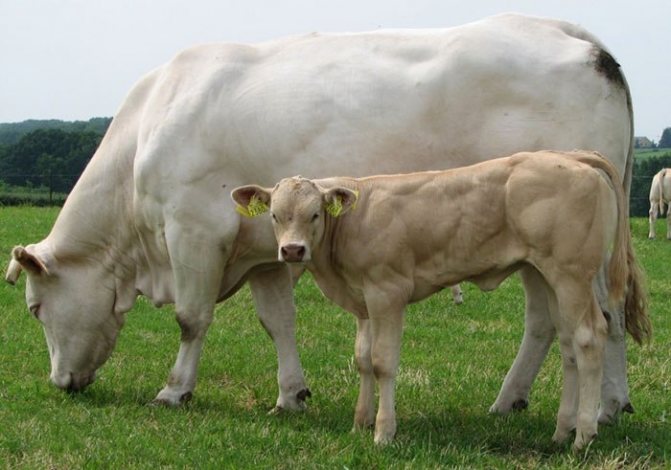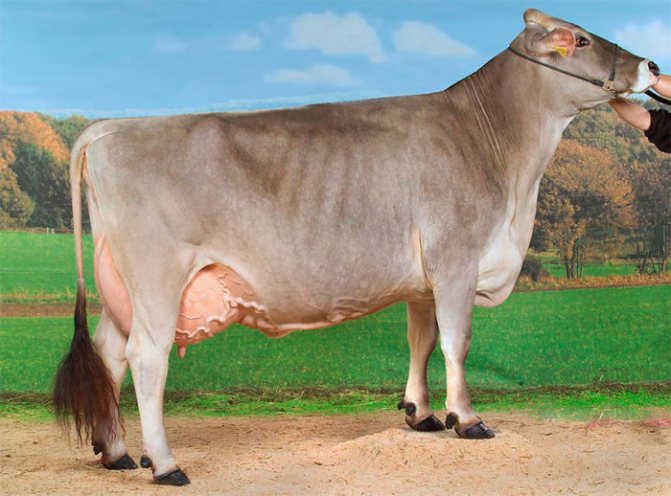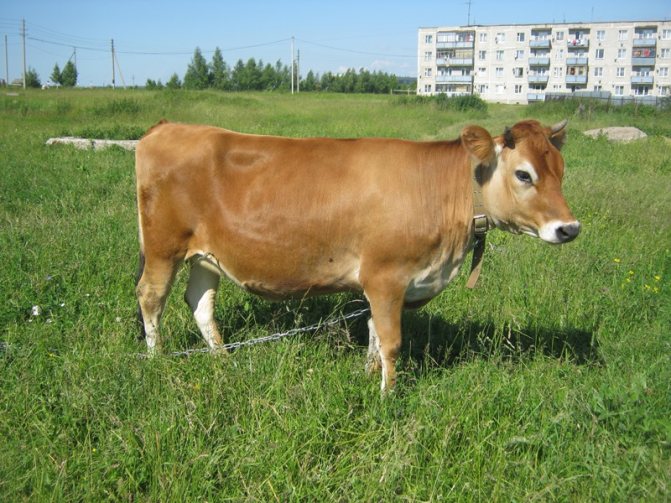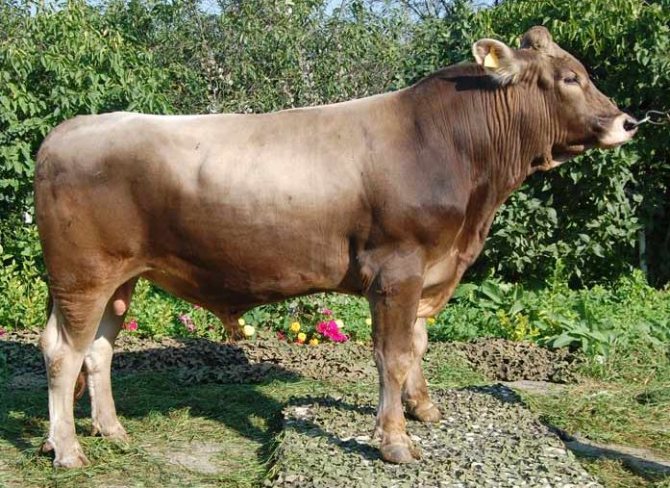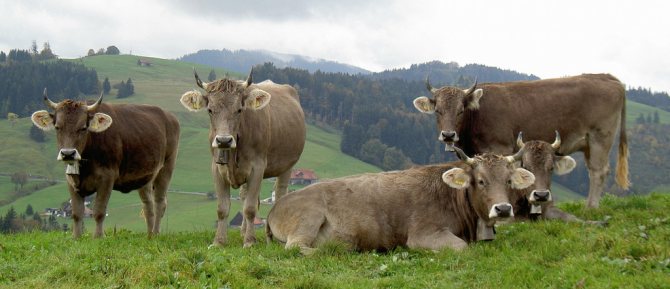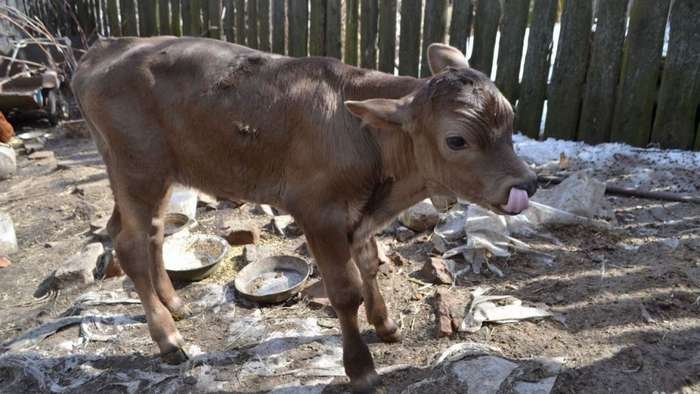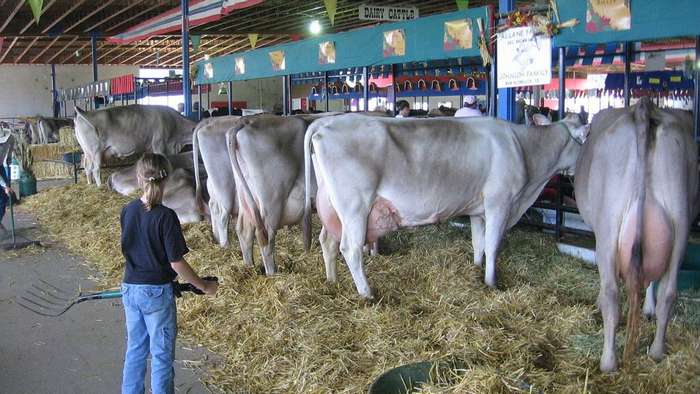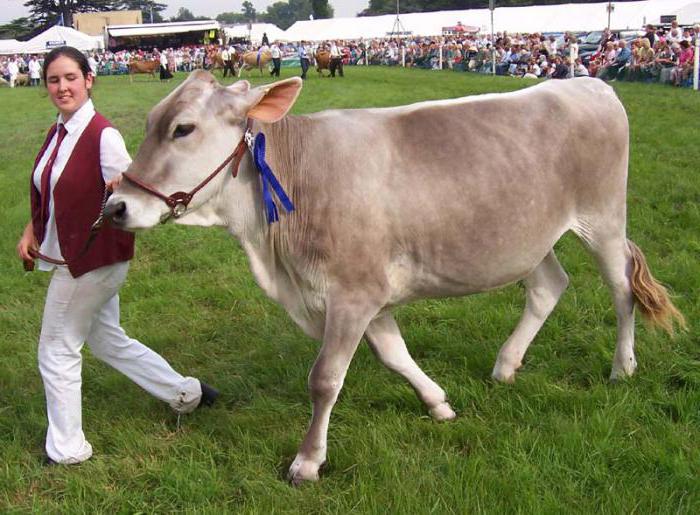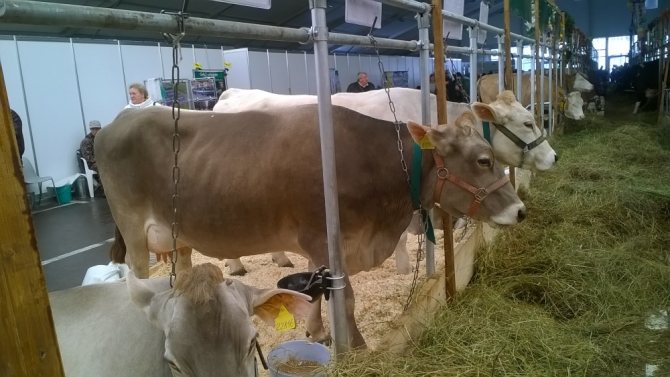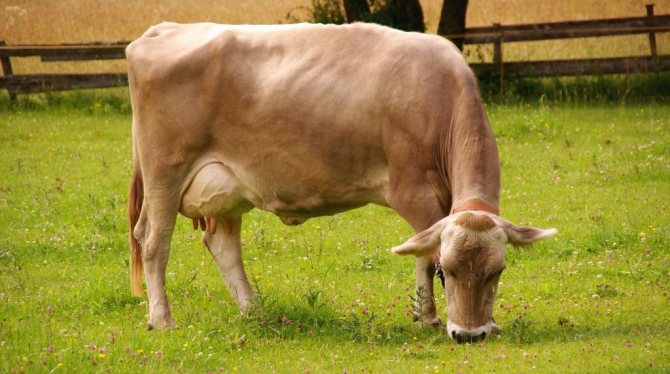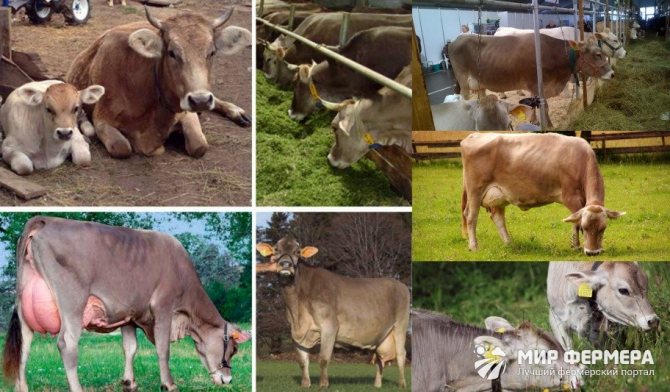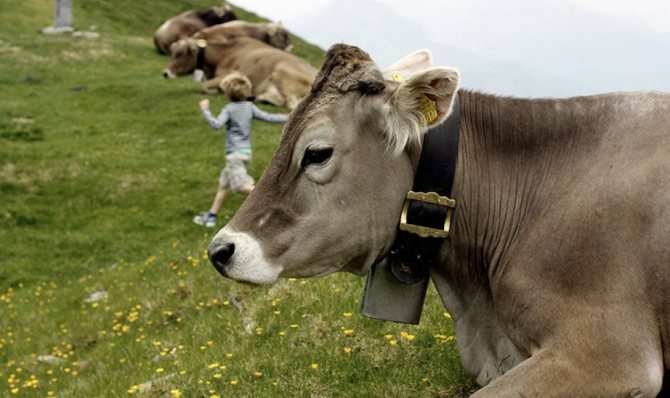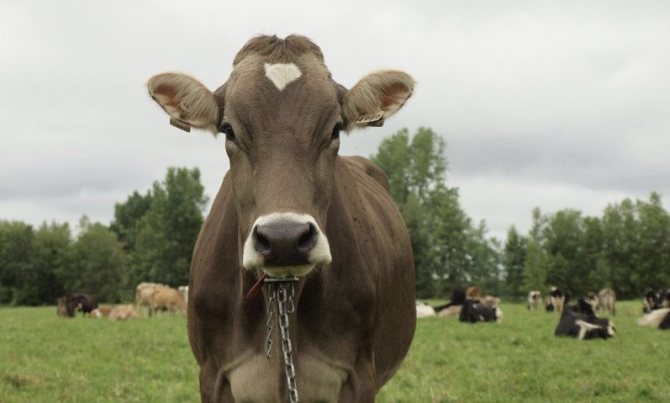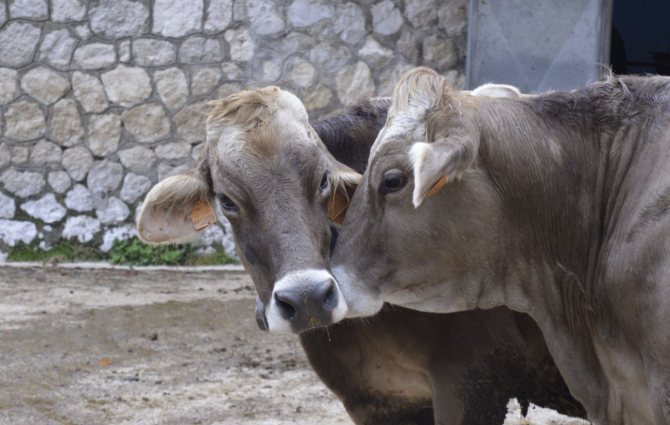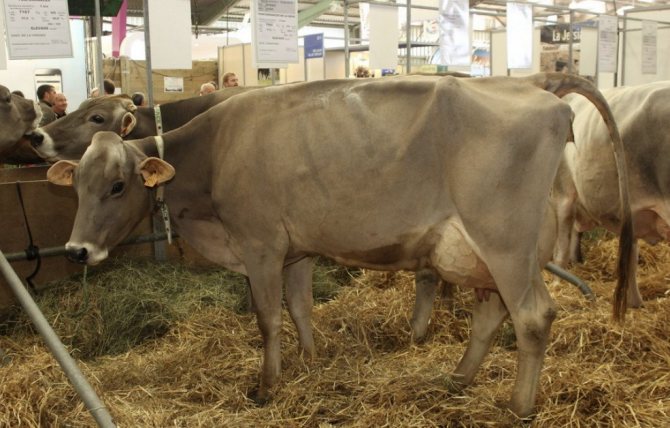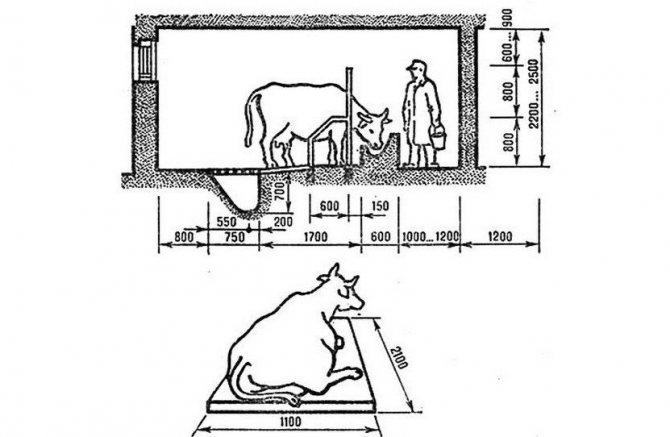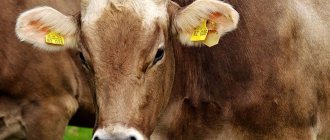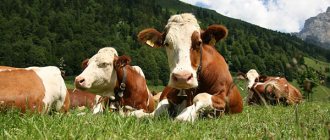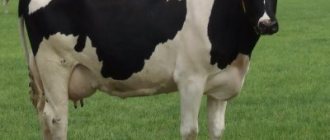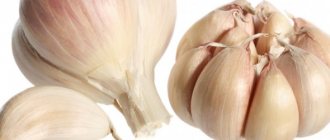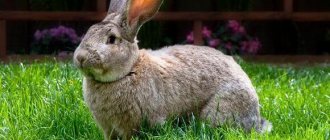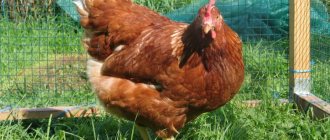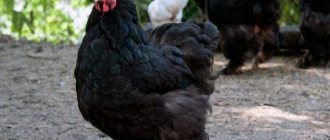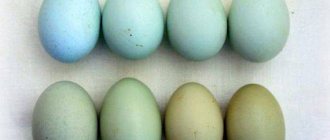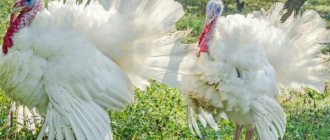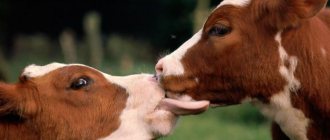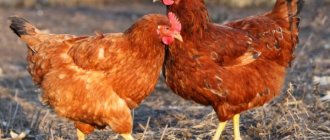Origin story
The first mentions of the Schwyz breed of cows were noted in the distant XIV century. The mountain canton of Schwyz - this area of Switzerland is directly related to this breed, because there it was bred by crossing local cows with oriental individuals. This pursued a specific goal - to breed an animal from which it will be possible to get a lot of milk and meat. In those days, a lot of attention was paid to another characteristic - the cow had to have working qualities. Therefore, only the strongest and healthiest individuals with the best productivity were used for crossing.
The goal was achieved, the new breed turned out to be highly productive in all directions: early maturing, with an excellent physique. Breeding work does not stop to this day. In particular, there are now two subspecies within the Swiss breed: valley cows and mountain cows. Both varieties have some distinctive features, and this is used to improve the breed.
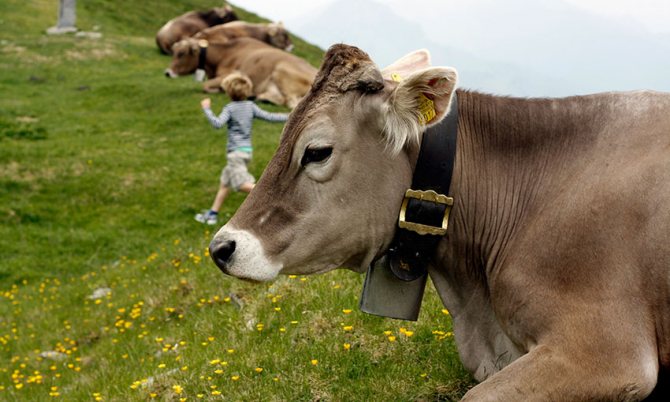
conclusions
- The Swiss breed of cows was bred in Switzerland, today it can be found almost anywhere in the world.
- They have a high price tag, therefore they are not often used for mass breeding, but can be used for inbreeding, as well as for obtaining high quality milk.
- Within the breed, several types are distinguished depending on the direction of productivity. They have a different constitution and content characteristics.
- Swiss cows are picky about food and content. It is important to correctly organize the barn, observing all the norms.
- This cattle breed has good health and strong immunity., and also has almost no congenital developmental pathologies.
Scope of distribution
Initially, the Swiss breed was present only in the historical area, but over time, such individuals began to appear in Italy, Germany, Austria. Such animals also came to America, but much later, in the 20th century. Naturally, due to being in other countries, the breed underwent some modifications, because individuals had to be crossed with the breeds prevailing there. Thus, in Italy, the Swiss cow has a greater meat yield, while in Germany and Austria, individuals, on the contrary, are smaller in size.
This breed has not spared Russia either. Here she first appeared in the 19th century. At first, adults were brought in - bulls and heifers, they were crossed both among themselves and with the local livestock. As a result of this selection, the Brown Swiss breed of three different subspecies was bred: dairy, meat and dairy-meat.
Bulls were distinguished by breeding qualities, so they were specially kept at breeding points and were widely used to improve the breed of local cattle. The Swiss breed gained distribution in Russia in the Smolensk province and in the Moscow region. The largest distribution of the breed was noted in 1925 after the breed was included in the State Committee for Pedagogical Rights - the state book of pedigree animals. Today, the most often grown universal, dairy and meat, Swiss breed. About 2% of the total cattle population in Russia is made up of Swiss cows.
The origin of the Swiss cow breed
The brown Swiss cow is one of the oldest breeds of cattle currently cultivated.It was bred about 700 years ago in the mountainous region of Switzerland, today known as the canton of Schwitz (hence the name of the breed). When creating a Swiss cow, short-horned cattle were used, which had been brought to Europe from Asia long before that, which were crossed with local outbred livestock.
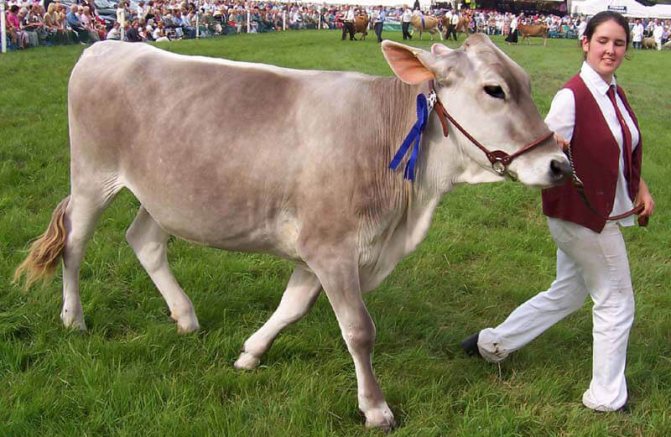

The main goal of the then breeders was to create a breed that is as hardy and resistant to the difficult natural and climatic conditions of the Swiss alpine pastures. At the same time, great importance was also paid to good performance indicators, which was achieved not only by selection, but also by creating special conditions for keeping and feeding animals.
It is interesting that at the first stage of the formation of the breed, livestock breeders, among other things, sought to increase the endurance of animals, including in order to use this livestock for agricultural work. But when the need to recruit livestock to work in the fields disappeared, breeders focused entirely on improving the beef and dairy productivity of cows.
After the Swiss were developed into a stable breed, they began to be bred outside Switzerland, primarily in neighboring Italy, Austria and Germany. By the beginning of the 19th century, the breed was already quite well known and enjoyed considerable respect in Europe, so they began to import it to the New World and especially to the USA.
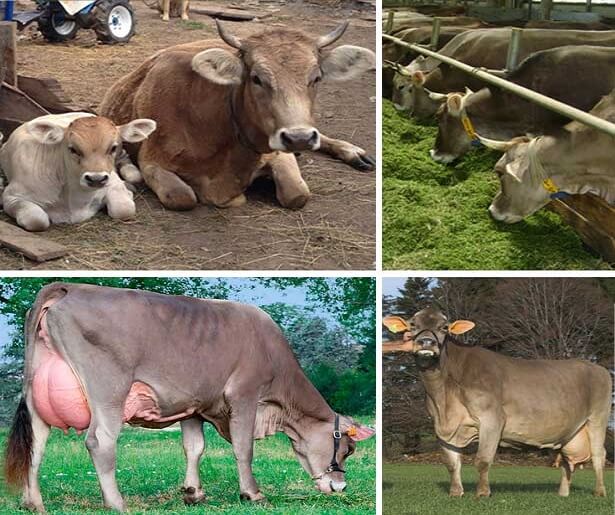

The Swiss dairy breed of cows came to Russia in the second half of the 19th century. However, the purebred Swiss were not very popular with us at that time due to the high requirements for the conditions of detention and the order of feeding. However, Swiss cattle were involved in the formation / improvement of such breeds as Kostroma, Brown Carpathian, Caucasian Brown, etc.
Since the breed managed to spread far beyond its historical homeland for a long time, each country where it has been bred for a long time has formed its own subtype of the Swiss cow. Often, these national subtypes are very different from those cows that are still bred in the canton of Schwitz.
For example, in Austria and Germany, representatives of this breed are noticeably smaller (which is typical for dairy cows), while in Italy and France, breeders, on the contrary, worked to increase the live weight and meat productivity of this cattle. As for Russia, we breed universal Schwyz with a slight bias towards dairy production.
Characteristics
As already mentioned, in each country the Swiss breed has received some of its own changes, but it is customary to refer to generally accepted standards:
- Brown color, various shades are possible. A light stripe can be seen along the ridge. As a rule, bulls are more intensely colored, the head and front part of the body are dark.
- The body of such animals is proportionally folded - it is stocky and strong, the legs are straight and not too long. The neck is not too long, but muscular, the head is small and neat with a broad forehead.
- Animals have thin and elastic skin.
- Another characteristic feature is that there is a lead-colored rim and a fringe of fine hairs around the nose.
- Bulls are quite tall compared to cows of other breeds, they reach 150 cm at the withers, while the body length reaches 170 cm.
- The dairy Swiss cow can be distinguished by its more elongated body and flat ribs, fragile skeleton, rounded belly and large udder.
- Milk-meat direction is characterized by well-developed muscles. The udder in this case is much smaller and has the shape of a bowl.
- The meat type of this breed has loose muscles, a powerful convex chest and an underdeveloped udder.
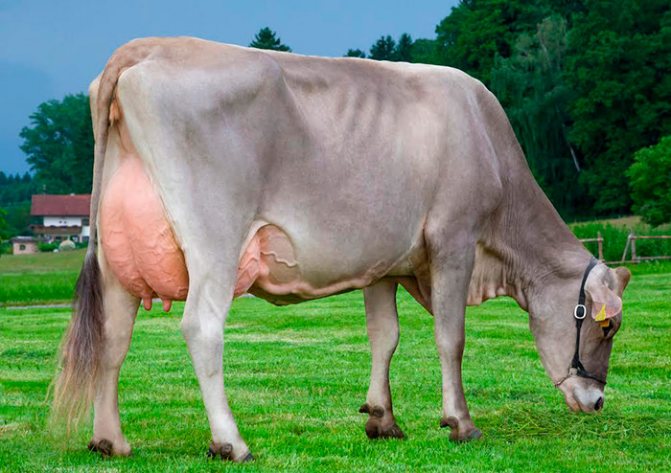

Jersey breed
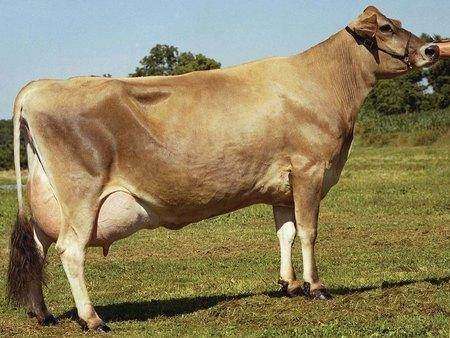

Jersey breed of cows. a dairy breed, developed in England (Jersey Island, Jersey) by improving the local Norman and British cattle and selecting them for their fat milk content.Inbreeding was widely used, as a result of which a delicate, dry, often overdeveloped constitution was entrenched in the breed. Animals have a wide, depressed forehead, well-developed eye sockets, and a short facial part of the skull; the neck is long, flat; the chest is deep but narrow; the withers are often sharp and high, the ribs set obliquely, rounded; the loin is long; wide ass. Exterior and constitutional defects are common. Color from light red and fawn to dark brown. The weight of bulls is 600-700 kg, cows are 360-400 kg. Milk yield of cows on average 3500 kg per year, fat content of milk 5-6%.
The breed is bred in England, the USA, Denmark, New Zealand, Canada, France, Australia, and others. The breeding farm was first introduced to the USSR in 1947. Jersey bulls are used in crossing with dairy cows to increase the fat content.
Productivity
The productivity of this breed and its universal variety is determined in the following areas:
- Weight gain is an important indicator. Calves of this breed are capable of adding 1 kg per day with proper care. At the same time, they are born large and weigh 35-40 kg. If all recommendations for maintenance are fully followed, then by the end of the first year of life the calf will weigh about 250 kg, at 1.5 years 370 kg.
- Adult weight. Animals of this breed are large. For example, a cow can weigh up to 800 kg, a bull up to 1000 kg. The meat yield during slaughter depends on the direction of the breed and the fatness of the animal and is 50-60%.
- Milk yield. On average, cows of this breed give 3-3.5 tons of milk during the lactation period, its fat content ranges from 3.6-3.8%. In good breeding farms, with an abundant balanced diet, a cow can produce up to 5 tons of milk. There are record holders who produce up to 12 tons of milk per year. The milk of such cows is so highly prized that it is widely used in cheese making.
Holstein
Developed as a result of natural breeding... There were no special crosses to obtain Holstein cows. In the eighteenth century, the improvement of the quality of the breed was carried out through careful selection. During the same period, the Holstein species gained popularity in agriculture in Europe.
The Holstein breed of cows, the photo of which can be seen below, is meat and dairy type of cattle, popular on farms both in Russia and abroad. The breed demonstrates high performance indicators: impressive milk yield and fast weight gain.
Holstein's appearance provides the following characteristics:
- Height at the withers is one and a half meters.
- The weight of an adult cow reaches 800-900 kilograms. The bull's weight often exceeds a ton.
- The body shape characteristic of the dairy type: the body is elongated, has a wedge-shaped shape.
- The shoulders and loin are broad.
- The udder is tucked up, with prominent veins.
- The color has two main colors, which occur in different proportions. There are completely white, black, and spotted variegated individuals.
Holshtinskaya has the highest milk production. The specific quantity of the product is largely depends on climatic conditions, as well as from the region of residence of the livestock. The fodder supply also plays an important role in productivity.
The average amount of milk received from one cow ranges from 5 to 11 kilograms. The product has a high fat content - about 4% and a large amount of protein - 3.5%.
Growth the body weight of a bull is one kilogram per day. The breed has good meat qualities. Slaughter yield reaches 60% of the mass.
Pros and cons
Like any other, the Holstein cow has its own advantages and disadvantages. Among the positive aspects of breeding the breed, the following characteristics should be noted:
- High rates of milk yield.
- Early maturity. A cow reaches 350 kilograms in a year and a half.
- Possibility of early fertilization.
- Good adaptation to weather changes.
- Fast weight gain.
- Strong immunity.
The cow also has some limitations:
- Cows are susceptible to stress, which can negatively affect milk yield.
- High breed hygiene requirements.
- Whimsical diet.
- High maintenance costs.
Advantages and disadvantages
The breed, which has arisen as a result of complex breeding work, has many advantages. These include:
- Easy acclimatization and endurance. Short-term stress or not too long stay in unfavorable conditions will not affect the productivity of individuals, as well as their general well-being.
- Immunity, which allows individuals to resist many diseases inherent in cattle.
- Good-natured, friendly, calm disposition. Moreover, the kindness of these cows is manifested both in relation to people and to relatives. However, there is a clear hierarchy in the Swiss herd. The leader is elected once and remains so forever. The direction in which the herd will move depends on the leader.
- Early maturity and high reproductive qualities. The probability of a dead calf birth is minimal
- The fat content of milk, which makes it suitable for making cheese and butter. The fat content of milk fully compensates for the not too high milk yield from these cows.
- Accelerated growth and muscle gain.
Of course, speaking about the advantages, we must not forget about the disadvantages:
- Difficult milking, milk output is up to 1.2 kg per minute. This is a feature of all Swiss cows, due to which machine milking is almost impossible, because the machines are designed for a higher milk delivery rate.
- Finicky food. Individuals of this breed will not eat musty and stale food. In addition, it is sometimes advisable to alternate feeds to create some variety. This increases productivity.
- Lack of ability to use individual cows for machine milking. This is due to the fact that the udders of heifers are often formed incorrectly and can only be milked by hand.
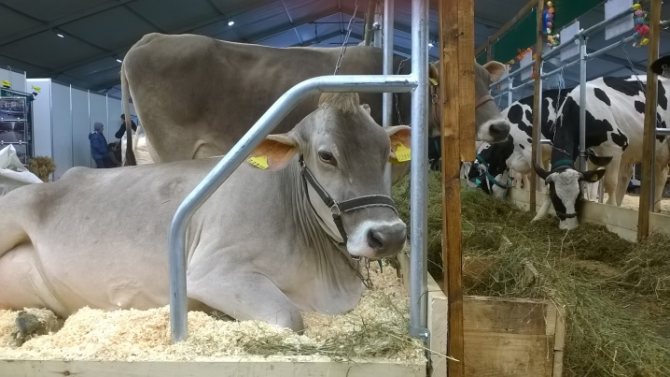

Pros and cons
Shvitsy cows are especially popular in their country of origin. The famous Swiss cheese is made from their milk. They are also widespread in Germany, Italy, Austria, America. But in the vastness of the former USSR, breeding cows are a rarity.
- This phenomenon is difficult to explain, because the breed has a large number of positive qualities, namely:
- strong immune system;
- fast acclimatization and adaptability regardless of weather conditions;
- an even character, characterized by calmness and peacefulness;
- fairly high reproductive rates;
- rapid growth and development.
- There are few minuses, but they are still there. Basic:
- selectivity and some finicky diet;
- low milk flow, namely: about a liter per minute;
- the structure of the udder in some individuals does not allow them to be milked automatically.
Diet
In order for the young to fully develop, and the adult to give as much milk as possible, a full-fledged balanced diet is necessary and important. It should contain good hay, silage, roots, bran (they are needed in winter).
In the summertime, cows make do with pasture grass, but not every pasture is suitable. There should be good juicy grass on it. For this purpose, clover, vetch, peas and alfalfa are specially sown. Then, closer to autumn, the same grass is mowed and hay is prepared. Steppe pastures with stunted vegetation are not suitable for Swiss cows.
Important! Cows of this breed are finicky. Therefore, they need to be fed abundantly and varied. Their health and quality of milk directly depends on this. In any case, the basis of the diet is hay, roots and bran.
The optimal feeding scheme in the morning and in the evening is water, hay, compound feed, and in the afternoon - hay and water.
Conditions for keeping cows of the Swiss breed
For all its endurance and versatility, the Swiss breed of cows is known for its capriciousness to housing conditions and diet. Any deviations from the established recommendations greatly reduce the already fairly average milk production, and also affect the meat characteristics.
The diet of this breed should be based on dry hay, silage, bran and fresh vegetables. In summer, animals must be released for free grazing, preferably on specially prepared meadows with pre-planted perennials of the most preferred species. To increase milk production and milk quality, it is very important that the feed contains peas, clover, vetch and alfalfa.
It is believed that the stall-pasture method is more preferable for the Swiss breed, since cows give better quality milk on free grazing. However, some farmers practice stall housing all year round. In this case, in summer, animals must certainly be fed, in addition to compound feed, also with fresh herbs. This method is more suitable for farms specializing in meat and dairy or purely meat production.
Newborn calves and freshly calved cows need increased attention. In the composition of their diet, it is imperative to include oat-bran mixture, which will allow the cow to quickly gain strength and recover from childbirth.
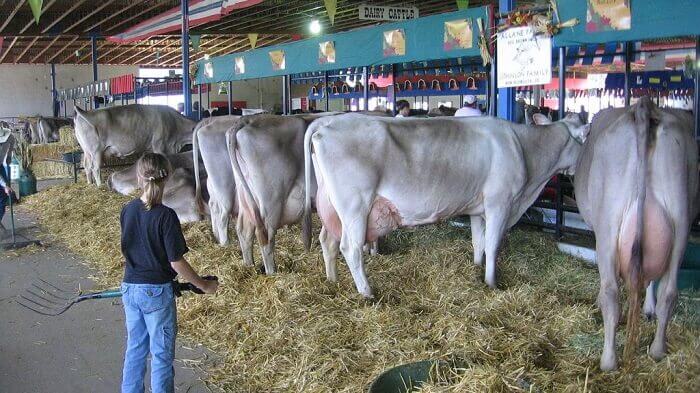

For the main herd, the following diet is recommended: in the morning - water, hay and compound feed, in the afternoon - water and hay, in the evening again compound feed and hay with water. Also, daily animals need to be given a certain amount of green juicy feed - vegetables, grass, silage, etc.
Content
The main methods of keeping Swiss cows:
- Stoilovy. It is ideal for farms where calves are kept and there is an adequate supply of various feeds available all year round.
- Stable pasture. This is the main method for private households. It turns out that feed needs to be prepared only for the winter. In the warm season, cows graze on pastures.
A warm, ventilated room plays an important role in the normal development of cows. It is also necessary to take care of the free space for each cow. Ideally, this should be a room of about 2-4 m2, with high ceilings. You also need to count on the fact that the first time after calving, the calf will be sucked with the cow.
Swiss cows and bulls are very heavy, so attention must be paid to the floor in the barn, which must be solid. It is important that the cow's hooves do not slide over it. This is fraught with various injuries. It is required to provide natural light in the premises for the cows. Cleaning and changing the bedding is the foundation of cattle care. The cows are brushed periodically. The udder requires hygiene - it is washed before each milking with soapy water. In order to prevent the formation of cracks in the udder, after milking it is lubricated with special compounds.
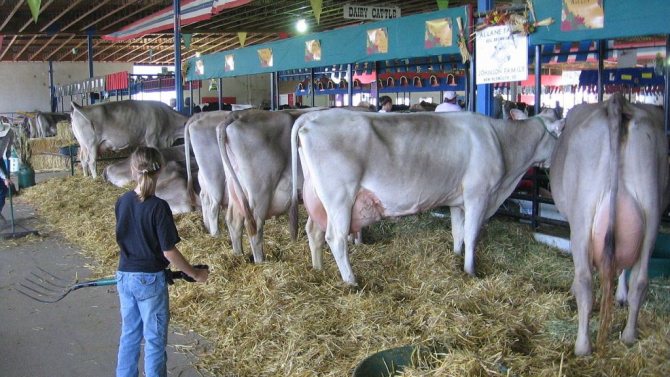

Health
As already mentioned, strong immunity is inherent in this breed. It is enough to regularly sanitize the barns in order to exclude morbidity in the herd. Weekly treatment of the premises, feeders, drinkers with special disinfectant solutions or boiling water reduces the likelihood of diseases. Processing is important before the young animals are resettled. calves do not yet have such strong immunity as adults. As a preventive measure, you need to monitor the cleanliness of animal hair. Dirty wool easily and quickly develop pathogens that cause various diseases.
Due to frequent milking, cows sometimes develop mastitis, and it is also provoked by increased feeding. When a cow becomes very fat, her bones become thinner, problems with joints appear, therefore supplements with calcium and table salt must be constantly present in the diet.
Important! Vaccination is carried out annually, which minimizes the likelihood of contagious diseases. Regular check-ups are also required.
Breeding
In order to select females for offspring, they begin to look closely at young heifers from the age of 1.5 years. An animal older than 9 months is suitable for mating. After mating, the cows are kept with the entire herd. Insemination occurs naturally or artificially (the latter is considered effective).
Approximately 2 weeks before calving, the animal is moved to a separate room - warm, dry and draft-free, with abundant bedding. Sometimes cows need to be assisted at delivery. calves are born quite large, which makes calving very difficult. After calving, it is important to avoid mastitis. When calves are born, they need to be watched, they should always be warm. In addition to the milk that is given to the calf, it needs to be fed with oat-bran mixtures. You can give such a mixture to the cow so that she recovers as soon as possible after giving birth.
After calving, she needs peace and good nutrition, vitamin supplements are added to the feed. Swiss cows have a strong maternal instinct. They feed the calf, take care of it. Often, calves are weaned from the cows so as not to disrupt the milking regime. Then they are fed with milk by hand, sometimes adding vitamin supplements. Adult feed is introduced gradually, observing the well-being of the calf.
Newborn calves are burned out from the horns at a very early age. This is done so that they don't hurt each other as they grow up. This technique also allows you to keep a larger number of individuals in a small area.
Swiss cows live up to about 20 years. Older cows (over 15 years of age) are slaughtered as soon as they stop lactating. At this age, offspring from such a cow is no longer necessary, so the maintenance becomes unprofitable.
In order to get healthy and purebred offspring, only the best representatives of the breed, productive and possessing all the necessary characteristics, must be selected for the tribe. During its life, one cow is able to bring up to 18 calves.
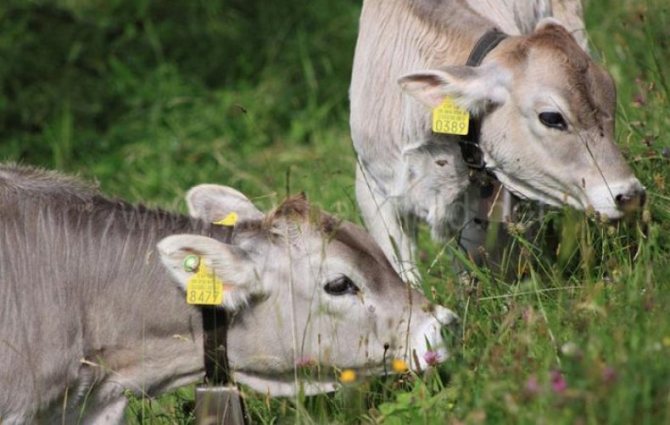

Perspectives
The total number of cattle in Russia is about 19 million heads, the number of Swiss cows is only about 1000 individuals. It is noticeable that this breed is not popular, which is due to the whimsicality of animals and a lack of productivity. This also includes difficulties in leaving and problems with breeding. Breeders of such cows note that the high adaptability of individuals to climate and weather can compensate for some of the breed's shortcomings. Whether the region is cold, humid or hot and arid, Swiss cows will take root everywhere. Swiss cows will also be able to live in the highlands.
According to farmers' reviews, Swiss cows have a good return on investment. This is due to their good health, excellent adaptation, the ability to graze the herd on any terrain without negative consequences for the hooves. Even high-mountainous areas with lush grass are suitable for pastures. Experienced breeders also note that if the cow does not like the feed, she may refuse it. The fact that the herd grazes on meadows most of the time in the warm season allows you to save on fodder.
Purchase
The cost of cows of this breed can reach 50 thousand rubles. The final cost depends on the age, productivity and characteristics of the breed. For breeding, it is recommended to purchase young heifers at the age of 7-8 months. If there is a goal to buy a purebred Swiss calf, then you need to familiarize yourself with the documents. It is required to study the external data of the animal and establish whether its appearance fits the description of the breed.A veterinary certificate is presented upon purchase. It indicates the health of the individual.

